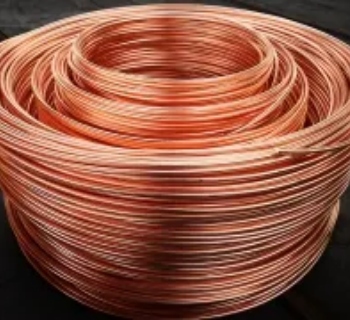Oxygen-free copper rod, or OFCR, refers to a high-purity copper rod produced through refining that removes most of the oxygen and other impurities. OFCR is widely used in electrical and electronic applications due to its outstanding conductivity, corrosion resistance, and mechanical properties. It is a crucial material in manufacturing wires, cables, connectors, and other components that require high conductivity and durability.
High conductivity: Due to its extremely low impurity content, the C10200 copper alloy provides excellent conductivity, making it an ideal choice for fabricate high-quality cables and wires.
High thermal conductivity: In addition to conductivity, this copper alloy also has high thermal conductivity, making it suitable for applications such as radiators and heat exchangers that require good heat dissipation.
Good processing performance: Oxygen-free copper can be formed through cold and hot processing without affecting its weldability and workability due to oxygen content.
Excellent corrosion resistance: C10200 copper alloy exhibits good corrosion resistance in most environments, especially in dry environments.
Good weldability: Due to its extremely low oxygen content, C10200 is less prone to porosity during welding, ensuring the welded joint's quality and strength.
Wire and cable: Due to the high conductivity and corrosion resistance of oxygen-free copper rods, they are often used to manufacture high-quality audio and video cables and communication cables. These cables can provide better signal transmission efficiency and smaller signal loss.

Oxygen Free Copper Rod used for wires and cables
Aerospace: The high conductivity and thermal conductivity of oxygen-free copper rods, as well as their excellent processing performance, have made them widely used in the aerospace field, such as in the manufacturing of wires, busbars, etc.
Automotive industry: In the automotive industry, oxygen free copper rods are used to manufacture key components such as electronic tubes and superconducting magnets to improve the performance and safety of automobiles.
High-fidelity audio equipment: Oxygen-free copper rods are also widely used in manufacturing audio cables and connectors to ensure maximum transmission efficiency and minimal distortion of audio signals, providing a high-quality audio experience.
Semiconductor devices: The high purity and stability of oxygen-free copper rods make them excellent in manufacturing high-frequency circuits and other high-precision electronic components. Its excellent conductivity ensures the reliability and performance of the equipment.

Company Profile
NANOTRUN(www.rboschco.com) is a trusted global chemical material supplier & manufacturer with over 12-year-experience in providing super high-quality chemicals and nanomaterials, including boride powder, nitride powder, graphite powder, sulfide powder, 3D printing powder, etc.
The company has a professional technical department and Quality Supervision Department, a well-equipped laboratory, and equipped with advanced testing equipment and after-sales customer service center.
If you are looking for high-quality Oxygen-free Copper Rod, please feel free to contact us or click on the needed products to send an inquiry.
Payment Term
L/C, T/T, Western Union, Paypal, Credit Card etc.

Shipment Term
By sea, by air, by express, as customers request.
Storage Conditions:
Sealed container: Ensure that LAS-IPA is stored in a well sealed container to prevent the entry of air, moisture, and other impurities. This helps to maintain its purity and performance.
Cleanliness: Ensure the storage area is clean and free of dust, dirt, and other contaminants. This is crucial to prevent corrosion and maintain the purity of the copper rod.
Humidity Control: Control the humidity level in the storage area to prevent corrosion. High humidity can give rise to the formation of copper oxide, which can affect the conductivity and appearance of the copper rod.
Temperature Control: Maintain a stable temperature in the storage area to prevent thermal expansion and contraction of the copper rod. Sudden temperature changes can affect the mechanical properties of the material.
Packaging and Protection: Store the copper rod in suitable packaging to protect it from external damage, scratches, and moisture. Wrapping or covering the rods with a protective material such as paper or plastic can help maintain their quality.
Segregation from Other Materials: Avoid storing oxygen-free copper rods with other metals or alloys that may cause galvanic corrosion. Galvanic etch occurs when two different metals are in touch with each other and an electrolyte, leading to the corrosion of one or both metals.
Loading and Unloading Care: When loading and unloading the copper rods, handle them carefully to avoid bending, twisting, or other mechanical damage.
Inventory Management: Keep track of the stock and rotate the stock regularly to guarantee that the oldest material is used first. This helps persist the quality and consistency of the copper rod.
Inspection and Quality Control: Regularly inspect the copper rods for any signs of corrosion, damage, or contamination. Perform quality control tests to ensure the rods meet the specified standards and specifications.
Q1
How can to ensure the high purity of oxygen-free copper rods meet oxygen-free standards during production?
Re:Ensuring high purity and meeting oxygen-free standards is crucial in producing oxygen-free copper rods. This is usually achieved through the use of refining and purification techniques. The refining process includes electrolytic and pyrometallurgical refining, which can effectively remove impurity elements such as oxygen, sulfur, and other metal impurities from copper. In addition, the selection of raw materials and processing conditions will be strictly controlled during the production process to avoid reintroducing oxygen or other impurities.
Q2
What are the mechanical properties of oxygen-free copper rods, and are they suitable for applications that require high tensile strength or fatigue resistance?
Re:Oxygen-free copper rods have excellent mechanical properties, including high strength, elasticity, and fatigue resistance. This makes it suitable for applications that require high tensile strength or fatigue resistance. For example, oxygen-free copper rods are commonly used in electrical and electronic fields to make components such as wires, connectors, and terminals, which require high tensile stress and fatigue resistance.
Q3
What are oxygen-free copper rods' unique advantages or limitations compared to other copper materials?
Re:Oxygen-free copper rods have some unique advantages and limitations compared to other copper materials. Its advantages include high purity, high conductivity, good mechanical properties, and corrosion resistance. These advantages make oxygen-free copper rods widely used in electrical, electronic, communication, and energy fields. However, anaerobic copper rods also have some limitations. Due to its high purity and low impurity content, the cost of oxygen-free copper rods is relatively high.
Q4
How is the machinability and weldability of oxygen free copper rods, and is it easy to machine into the desired shape and size?
Re:Oxygen-free copper rods have good machinability and weldability, which makes them easy to machine into the desired shape and size. Oxygen-free copper rods can be formed through processing techniques such as cold drawing, rolling, and forging to meet the needs of various applications. Meanwhile, the welding performance of oxygen-free copper rods is superior, and they can be connected through conventional welding methods such as gas welding, TIG welding, and MIG welding.
Q5
Will anaerobic copper rods undergo oxidation or performance degradation during long-term use, and how can this process be prevented or slowed down?
Re:During long-term use, oxygen-free copper rods may still undergo oxidation due to exposure to air, resulting in the determination of a copper oxide layer on the surface, which affects their conductivity and appearance. Some measures can be taken to prevent or slow down the oxidation process. Firstly, a protective coating such as varnish, lubricating oil, or antioxidants can be applied to the surface of the oxygen-free copper rod to isolate contact between air and copper. Secondly, oxygen-free copper rods can be regularly cleaned to remove surface oxides and maintain their good conductivity and appearance.




